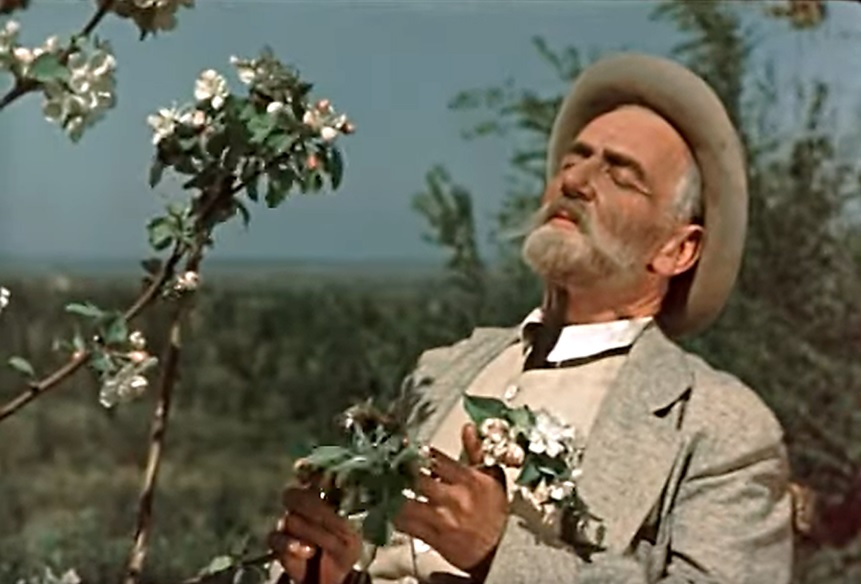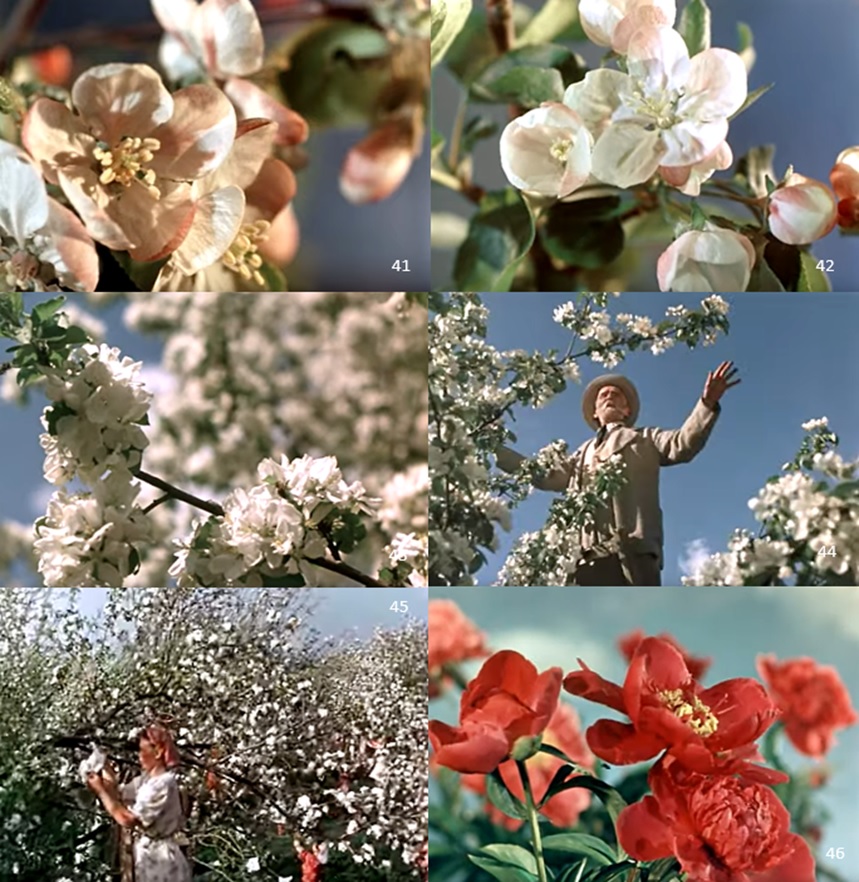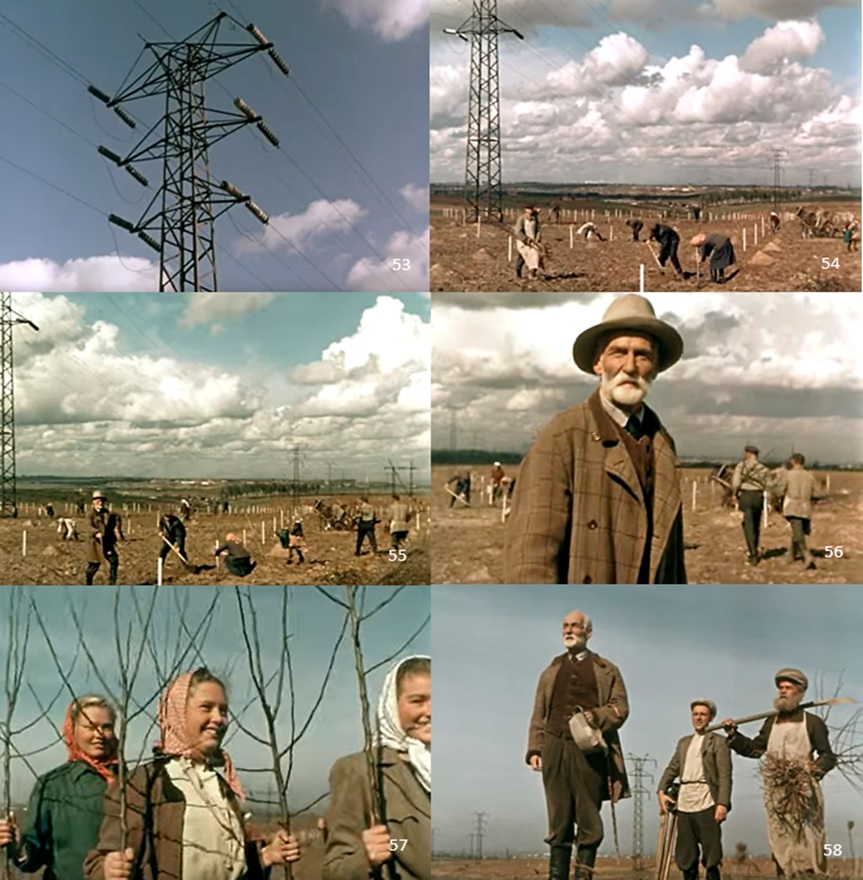![]()


![]()

![]()
■ From here, Dovzhenko's attempt begins to symbolically depict the earth by projecting the great nature of the Soviet Union ( 35~40 ). To understand how Dovzhenko's depiction of Nature impressed Shostakovich, the soundtrack producer, listen to his oratorio "Song of the Forests ( 1949 )". In particular, the lyrics of "No. 6 A Walk into the Future" and "No. 7 Glory" in "Song of the Forests" seem to have been written upon seeing the sequence ( 35-40 ) by lyricist Yevgeniy Dolmatovsky, who was received the intention of Shostakovich in writing the lyrics. As Shostakovich says in his autobiography, the collaboration with Dovzhenko in "Michurin" led him to "Song of the forests".
■ Here we see a glimpse of certain commonalities between Dovzhenko and Shostakovich, although they are rarely pointed out. Both men have historically provoked controversy in their political stances because of their "ambivalent stance", which is both pro-regime and anti-regime. The unconscious focus of the numerous controversies stemming from Solomon Volkov's memoirs of Shostakovich "Testimony ( 1979 )" is ultimately on Shostakovich's political thought rather than his humanity. It becomes ambiguous because everyone tries to see him only as a musical figure divorced from political thought, be it Volkov, those who disagree with him, those who agree with him, or his family.
■ It should be recognized that at the foundation of the construction of any problematic, whether it is pro- or anti-regime, politics or music as anti-politics, hides a shortsighted and unconscious view of things as to whether Shostakovich is a communist or a democrat. Curiously, everyone on either side would agree that they hope Shostakovich is a potential democrat who is dissatisfied with communism.
■ But was Shostakovich a potential democracy, as was Dovzhenko ? Does implying in the composition that they have the different true intention while superficially pandering to Stalinism really lead directly to being a potential democrat who opposes communism ? Isn't that the delusion of those who support democratic system ?
■ The truth may be that Dovzhenko and Shostakovich are anti-Stalinists, but not anti-Communists. They may be implicitly criticizing the Stalinist regime from the standpoint of Communists before Stalinism. Otherwise, neither Dovzhenko nor Shostakovich would have been able to produce works of art with the embedded historical energy of the Russian Revolutionary period. Because their works are filled with the explosive power of Zeitgeist of the past, they are able to uplift and give some kind of emotional impact even to those who are indifferent to political ideology in the present day.
■ Yes, Dovzhenko does not depict the earth as a mere hymn to nature, but as the resistance to the current political system, as he had already done in "EARTH ( 1930 )". It is important to note that Dovzhenko does not naively claim that we should reject politics itself and return to nature, just because he emphasizes nature. He is not a political recluse. He is secretly asserting the possibility of another politics in the art of cinema.
■ What is embodied as the possibility of another politics was Earth. This Earth is People, the collective people in solidarity with the workers and peasants, the basis of the Russian Revolution, which Stalinism used only as the object of its political exploitation. Dovzhenko resisted such political exploitation.

■ This sequence ( 41~46 ) evokes the connection to "EARTH ( 1930 )" in Image. In particular, the slow-motion opening of the petals ( 41~42 ) is not merely a hymn to nature, but the symbolic blooming of the people of the Soviet Union. "The collective of workers and peasants" at the bottom of Bolshevik hymns that Dovzhenko once depicted has been transformed into the Image of EARTH after it has been exploited by Stalinism. The political plight of the people who cannot speak freely is anthemically sublimated into the Image of flowers that embody their own beauty through their blooming, though they cannot utter a word.
■ What is interesting here is scene 44, where Michurin is surrounded by flowers and gestures as if he is conducting a piece of music. What on earth is he doing that for ? Of course, it is not to the physical flowers, but to the symbolic flowers in the sense of representing the people. In this light, we can see that Michurin, the conductor, is naturally superimposed on Lenin, the leader of the people.

■ Michurin talks with Kalinin under the evening sky in his own orchard. Kalinin ( 1938~1946 ) was an Old Bolshevik who participated in the Russian Revolution with Lenin and was dispatched by Lenin, who appreciated Michurin's work, to meet Michurin in person shortly after the revolution. Kalinin, who was dead at the time of Michurin's release, was only given a nominal position without power under the Stalinist regime as one of the few survivors of the Russian revolutionary period ( Stalin purged most of those with revolutionary experience ).
■ Dovzhenko's direction, which dares to depict such a dialogue between Old Bolsheviks Kalinin and Michurin, hides the intention to connect to the Russian Revolution before Stalinism.

■ The following sequence ( 53~58 ) is the scene neither of orchard cultivation nor of farm work. Perhaps it depicts the tree-planting project, one of Stalin's "Great Plan for the Transformation of Nature", which was the source of the idea for Shostakovich's "Song of the Forest" together with the film "Michurin", as already mentioned above.
■ It is notable for Scenes ( 53-54 ). Dovzhenko, who has been depicting nature up to this time, is suddenly depicting power transmission towers in large scale. But the scene is no surprise when one remembers "State Commission for Electrification of Russia ( Russian : Государственная комиссия по электрификации России )", known as "GOELRO ( Russian : ГОЭЛРО )", envisioned and promoted by Lenin beginning in 1920. The vision is to build the axis for industrialization by linking the various regions through the network of electrification throughout Russia.
■ Lenin's word, "Communism is Soviet power plus the electrification of the whole country", are perhaps the most famous word to symbolize this Soviet electrification concept. It spread not only as the actual industrial policy, but also as the ideological policy to praise Lenin, who brought electric lighting to every household. In other words, Lenin was also the symbol of electricity.
■ Understanding the above, we can see that Dovzhenko is bringing up Lenin in the roundabout way in this sequence as the implicit contrast to Stalin, who promoted the tree planting project.

![]()

![]()